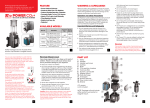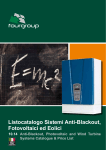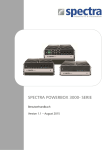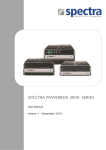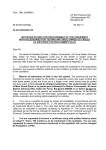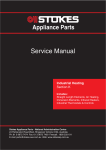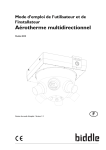Download Biddle CA2 Specifications
Transcript
New Wave in Climate Separation Technology What is Invisidor? Contents New Wave in Climate Separation Technology 1 What is Invisidor? 1 Why Invisidor CA2? 1 What Makes an Effective Air Curtain 2 Patented Rectifier 2 Discharge Velocity 2 Air Volume 3 Discharge Temperature 3 Automatic Control 3 CDF Software for Air Curtains 4 Applications Air Curtain Selection Technical & Performance Specifications Dimensional Drawings Hanging Brackets The Biddle Guide to CA2 Control Options 5-6 7-10 11-12 13 14-16 Circular Doorways 17 Installation & Maintenance 17 Materials, Components & Specifications 18 Invisidor CA air curtains are the ideal solution for retailers and consultants to combat the issue of climate separation across their outlet or office building doorway. Using a combination of rectifier technology, air velocity and temperature control they deliver greater comfort to staff and customers alike, all year round, in all weathers. Managers of retail and commercial outlets know the importance of accessibility for their customers. They also know that with this free form of access through ‘open door’ trading, comes the issue of cold draughts and high-energy bills. Now Invisidor technology has been improved to deliver greater comfort for all, whether it is in a supermarket, high street store or office building. The Invisidor CA air curtain, does not act as a barrier in the place of a door, its prime role is to reduce the amount of warm air leaving the building and condition the incoming air to a comfortable temperature. BSRIA and Biddle research produced documented evidence proving that air curtains operate best with specific velocities and air volumes. The Invisidor CA air curtain satisfies these needs by delivering the right air flow and temperature at the right time, reducing energy loss. It is the only commercially available air curtain of its kind that now offers a unique damper mechanism to improve efficiency, by controlling the outlet velocity. Why Invisidor CA2? The new CA2 air curtain is the next generation of CA air curtains, incorporating new energy saving technologies and a touch screen control panel. The increased use of condensing boilers has necessitated a revised coil design to ensure heat output is maintained despite the lower water temperatures. The key principle is that the maximum discharge temperature is limited to 50°C, and this can easily be provided with any water flow temperature above 70°C. There is a small compromise on heat output on the maximum strength as water flow temperatures approach 60°C, but on strengths 1-5 the outputs can generally be maintained. The integral 3-port valve controls the discharge temperature to assist in creating optimum comfort and efficiency. Knowing that manual control of air curtains often leads to the incorrect setting the inclusion of the energy saving self-regulating CHIPS technology ensures the most appropriate setting at any moment in time. This automatic control has been demonstrated to produce energy saving savings of up to 75% when compared with a manual controlled air curtain. The new b-touch control panel enables the installer and user to intuitively navigate various menus, and set-up the CA2 air curtain for either automatic CHIPS or manual control. Once the simple set-up procedure has been completed the automatic CHIPS control renders manual operation superfluous. 1 What Makes an Effective Air Curtain? Patented Rectifier A critical factor when selecting an effective air curtain is ensuring that incoming air is conditioned to an acceptable temperature as it enters the building. For this to be achieved, the air curtain jet must cover the full width of the building entrance, so that it cannot be bypassed by incoming air. However, ensuring the jet reaches the floor level is more challenging. Along with the TNO wind facility at Apeldoorn in the Netherlands, Biddle has successfully developed a patented rectifier to minimise turbulence in the discharge airstream. By reducing the turbulence, the induction of the surrounding air is also reduced, which increases the jet throw by 30-40% of an equal volume/velocity unit. The pressure chamber behind the rectifier evenly distributes the air stream across the whole width of the unit. The result is a deeply penetrating, laminar airstream, reducing energy consumption and increasing comfort levels Patented airflow rectifier Entrance with no air curtain all year round. Entrance with inefficient air curtain Entrance with Invisidor air curtain Discharge Velocity If the discharge velocity is too low then energy can be lost when the heated air leaves through the upper part of the door opening, via the convective current. Additionally, low velocities invariably do not reach floor level, resulting in the cold air entering without being treated. Ensuring that airflow reaches the floor in a doorway can be achieved by using a high velocity jet. This, however, has a negative effect on the efficiency of the air curtain. High velocity units create considerable turbulence in the surrounding air. Furthermore, when the air meets the floor, it spreads both in and out of the doorway, resulting in energy losses to the outside and creates internal draughts and thermal discomfort for staff and customers. Biddle Invisidor CA2 units are designed to be more effective in supplying the curtain of air at the correct discharge velocity, when it is more comfortable and where less energy is wasted. 2 Air Volume On more demanding days it is usual to increase the operational speed of an air curtain. Similarly on milder days the speed would be reduced. A standard air curtain with a fixed area discharge grille, means the air velocity increases or decreases accordingly, resulting in a drop in energy efficiency and comfort. One of the important differences between the Biddle CA2 air curtain and a standard air curtain is the inclusion of a patented damper mechanism. This assembly helps maintain the optimum relationship between air volume and discharge velocity – which we refer to as the air curtain strength or impulse. Discharge Temperature Biddle research showed that energy efficiency decreases with an increase in Damper mechanism is automatically controlled by PCB giving a controlled air strength discharge air temperature. Hot air is more buoyant and reduces the effect of good climate separation. Trials by Biddle investigated various temperatures, in order to ascertain which one would be most efficient and provide the highest levels of comfort throughout the year. Research found that a discharge temperature of 35°C ensures optimum comfort of those passing under the air curtain and anyone close to the entrance. Temperatures up to 50°C can be useful in extreme and demanding environments. An air curtain will bring about air movement at low level within the building, close to the door. Whether this is seen as comfortable is highly dependent on its temperature. At the specified temperature, comfort is not compromised. The Invisidor CA2 incorporates controls that automatically regulate the discharge air temperature. Automatic Control Damper mechanism fully opened providing a controlled air strength Customer research has established that at the time of installation an air curtain is typically set to operate at a mid-speed setting and rarely adjusted. This results in the air curtain continually operating at a single air volume, velocity and temperature. However as internal and external conditions constantly vary this means the air curtain will only be operating at the optimum setting some of the time, and for the rest of the time will be on either too high or too low a setting. To ensure optimum performance, enhanced comfort and minimal energy loss as conditions change the CA2 air curtain utilises CHIPS technology to automatically adjust discharge velocity, air volume and discharge temperature. Outside, return air and discharge temperature sensors are used to determine how much heat is required and the bespoke control algorithm ‘translates’ the data into the strength (a combination of air volume and velocity) required for optimal climate b-touch control pad 3 separation and comfort. CFD Software for Air Curtains Application CFD (Computational Fluid Dynamics) is a technique for modelling air flow and is an ideal tool for simulating the effects of air curtains in real-life building scenarios. It has already been used effectively during the design process of the Biddle air curtain range to optimise parameters such as discharge temperature and velocity. After extensive collaboration with the engineering department at the University of Warwick, Biddle now has a CFD package specifically designed for modelling air curtains and other ventilation equipment in the built environment. The program takes account of various aspects of the building, including location, precise geometry, leakage characteristics and wind profiles, to provide a solution unique to the building under consideration. This package has now been used successfully for over five years to provide information that enables consultants and architects to specify the correct climate separation system for their building from the earliest design stage. For example, simulations can be undertaken to examine the effect various air curtain models and different mounting configurations have, ensuring the final choice of unit provides an effective solution without compromising specification. Comparison of no air curtain v recessed air curtain. Shows beneficial effects of climate separation. The format of the CFD results depends on the situation modelled. They can be presented as air temperature profiles, speed profiles or velocity vectors. Without air curtain With air curtain The effect of building leakage 4 Air Curtain Selection Product Selector The ‘at a glance’ selector below will enable a simple selection of the most appropriate product for your entrance environment application. Please take time to consider the details on the following page. If you are unsure which unit suits your application, please contact the Biddle sales office. Air Curtain Product Selector MOUNTING HEIGHT 4.0m 3.3m 2.8m 2.4m • Medium High Street Retail Outlets/ Small Offices/ Commercial Reception Areas (up to 200m2) 5 • Medium Retail Outlets/ Foodstores/ Larger Commercial Entrances (200m2-2,5002m) • Large Retail Outlets/ Superstores/ Leisure Complexes (2,000m2-6,0002m) • Large Retail Outlets/ Hypermarkets/ Department Stores/ Shopping Centres with higher performance requirements (5,000m2 plus) Air Curtain Selection Design Considerations Biddle is part of your team. We work closely with consultants and architects from the earliest design stages to ensure the optimum air curtain solution is achieved for both new build and refurbishment projects. Critical design considerations include: • • • • • • • Store location, layout and age Building leakage characteristics Positive/negative pressurisation of the store Standard of mechanical air supplies Entrance doorway, width and height Multiple doors on different elevations Employee awareness of the problems caused by leaving bulk store doors open in foodstores • Lobbied/no door environment • Environmental factors - wind data, direction or speed The selection of an appropriate air curtain depends on: A. The door height (= mounting height, measured from floor to bottom of unit). B. The door width (recommended unit overhang - minimum of 100mm each side). C. The volume and temperature of the outside air entering through the open door. 6 Technical & Performance Specifications Invisidor CA2-S • • • • • Ideal for mounting up to 2.4m from floor to discharge Next generation of air curtains - available today Sets new standards of performance and efficiency Medium High Street Retail Outlets/Small Offices/Commercial Reception Areas (up to 200m2) Brings high-tech appeal to any entrance Water Heating Electrical Heating CA2-S 100 W CA2-S 150 W CA2-S 200 W CA2-S 250 W CA2-S 100 E CA2-S 150 E CA2-S 200 E CA2-S 250 E m 2.4 2.4 2.4 2.4 2.4 2.4 2.4 2.4 Optimum Door Width m 0.8 1.3 1.8 2.3 0.8 1.3 1.8 2.3 Unit Width m 1.0 1.5 2.0 2.5 1.0 1.5 2.0 2.5 kW Model Maximum Installation Height Heating Capacity Strength 1 Air Volume 2.5 3.7 4.8 6.1 2.5 3.7 4.8 6.1 2 3.3 4.9 6.6 8.3 3.3 4.9 6.6 8.3 3 3.8 5.7 7.6 9.4 3.8 5.7 7.6 9.4 4 4.7 7.1 9.5 11.9 4.7 7.1 9.5 11.9 5 5.4 8.1 10.8 13.5 5.4 8.1 10.8 13.5 6 8.3 12.5 16.7 20.8 8.3 12.5 16.7 20.8 Strength 1 m3/s 0.135 0.201 0.268 0.335 0.135 0.201 0.268 0.335 2 0.183 0.274 0.365 0.457 0.183 0.274 0.365 0.457 3 0.208 0.313 0.415 0.519 0.208 0.313 0.415 0.519 4 0.261 0.391 0.522 0.653 0.261 0.391 0.522 0.653 5 0.297 0.446 0.594 0.743 0.297 0.446 0.594 0.743 6 0.344 0.515 0.687 0.860 0.344 0.515 0.687 0.860 Water Flow Rate l/s 0.10 0.15 0.20 0.25 n/a n/a n/a n/a Coil Hyd Pressure Drop (Max) kPa 1.0 2.5 4.7 8.0 n/a n/a n/a n/a 230v/1ph/50Hz Electrical Supply Max Power Max Running Current Noise Level at 3m Weight (Dry) @Strength 3 Model F 400v/3ph/50Hz kW 0.20 0.30 0.40 0.49 10.5 15.6 21.0 26.1 A 0.89 1.33 1.77 2.22 3x16.0 3x23.8 3x32.1 3x39.9 dB(A) 36 38 39 40 36 38 39 40 kg 46 66 79 102 51 70 89 108 Model R 60 88 108 138 65 92 118 144 Model R(0) 54 78 95 122 59 83 105 128 Model C 58 83 102 130 63 87 112 136 Specification Codes Heating Capacities based on flow and return temperatures of 80/60°C, 20°C entering air and air outlet temperatures of: •Strengths 1.5 = 35°C •Strength 6 = 40°C In operation, the outlet temperatures will vary between 20-50°C max Correction Factors for other water flow temperatures 7 CA2 S-100 W CA2 S-150 W CA2 S-200 W CA2 S-250 W 82/71°C 1.00 1.00 1.00 1.00 70/50°C 1.00 1.00 1.00 1.00 60/40°C 0.94 1.00 1.00 1.00 Note: Factors to be applied to the heating capacity at Strength 6 only Technical & Performance Specifications Invisidor CA2-M • • • • • Ideal for mounting up to 2.8m from floor to discharge Next generation of air curtains - available today Sets new standards of performance and efficiency Medium Retail Outlets/Foodstores/Larger Commercial Entrances (200m2-2,5002m) Brings high-tech appeal to any entrance Water Heating Electrical Heating CA2-M 100 W CA2-M 150 W CA2-M 200 W CA2-M 250 W CA2-M 100 E CA2-M 150 E CA2-M 200 E CA2-M 250 E m 2.8 2.8 2.8 2.8 2.8 2.8 2.8 2.8 Optimum Door Width m 0.8 1.3 1.8 2.3 0.8 1.3 1.8 2.3 Unit Width m 1.0 1.5 2.0 2.5 1.0 1.5 2.0 2.5 kW Model Maximum Installation Height Heating Capacity Strength 1 Air Volume 2.8 4.1 5.5 6.9 2.8 4.1 5.5 6.9 2 4.1 6.1 8.2 10.2 4.1 6.1 8.2 10.2 3 4.9 7.4 9.9 12.4 4.9 7.4 9.9 12.4 4 6.4 9.7 12.9 16.2 6.4 9.7 12.9 16.2 5 7.5 11.3 15.0 18.8 7.5 11.3 15.0 18.8 6 11.0 16.5 22.0 27.5 11.0 16.5 22.0 27.5 Strength 1 m3/s 0.153 0.229 0.304 0.380 0.153 0.229 0.304 0.380 2 0.225 0.337 0.451 0.564 0.225 0.337 0.451 0.564 3 0.272 0.408 0.544 0.681 0.272 0.408 0.544 0.681 4 0.356 0.535 0.713 0.890 0.356 0.535 0.713 0.890 5 0.414 0.620 0.827 1.035 0.414 0.620 0.827 1.035 6 0.454 0.680 0.908 1.135 0.454 0.680 0.908 1.135 Water Flow Rate l/s 0.13 0.20 0.27 0.34 n/a n/a n/a n/a Coil Hyd Pressure Drop (Max) kPa 1.6 4.1 7.9 13.8 n/a n/a n/a n/a 230v/1ph/50Hz Electrical Supply Max Power Max Running Current Noise Level at 3m Weight (Dry) @Strength 3 Model F 400v/3ph/50Hz kW 0.28 0.42 0.56 0.70 14.0 20.8 28.0 34.8 A 1.30 1.95 2.60 3.26 3x22.7 3x33.8 3x45.5 3x56.5 dB(A) 37 39 40 41 37 39 40 41 kg 53 74 93 114 56 80 101 121 Model R 67 96 122 150 70 102 130 157 Model R(0) 60 87 108 134 63 92 116 140 Model C 65 91 116 142 68 97 124 149 Specification Codes Heating Capacities based on flow and return temperatures of 80/60°C, 20°C entering air and air outlet temperatures of: •Strengths 1.5 = 35°C •Strength 6 = 40°C In operation, the outlet temperatures will vary between 20-50°C max Correction Factors for other water flow temperatures CA2 M-100 W CA2 M-150 W CA2 M-200 W CA2 M-250 W 82/71°C 1.00 1.00 1.00 1.00 70/50°C 1.00 1.00 1.00 1.00 60/40°C 0.83 0.93 0.98 1.00 Note: Factors to be applied to the heating capacity at Strength 6 only 8 Technical & Performance Specifications Invisidor CA2-L • • • • • Ideal for mounting up to 3.3m from floor to discharge Next generation of air curtains - available today Sets new standards of performance and efficiency Large Retail Outlets/Superstores/Leisure Complexes (2,000m2-6,0002m) Brings high-tech appeal to any entrance Water Heating Electrical Heating CA2-L 100 W CA2-L 150 W CA2-L 200 W CA2-L 250 W CA2-L 100 E CA2-L 150 E CA2-L 200 E CA2-L 250 E m 3.3 3.3 3.3 3.3 3.3 3.3 3.3 3.3 Optimum Door Width m 0.8 1.3 1.8 2.3 0.8 1.3 1.8 2.3 Unit Width m 1.0 1.5 2.0 2.5 1.0 1.5 2.0 2.5 kW 5.8 8.6 11.6 14.4 5.8 8.6 11.6 14.4 7.6 11.4 15.2 19.0 7.6 11.4 15.2 19.0 3 9.5 14.3 19.1 23.8 9.5 14.3 19.1 23.8 4 12.3 18.4 24.5 30.7 12.3 18.4 24.5 30.7 5 14.5 21.7 28.9 36.1 14.5 21.7 28.9 36.1 6 22.1 33.2 44.2 55.3 22.1 33.2 44.2 55.3 Model Maximum Installation Height Heating Capacity Strength 1 2 Air Volume Strength 1 m3/s 0.318 0.476 0.636 0.794 0.318 0.476 0.636 0.794 2 0.419 0.627 0.838 1.047 0.419 0.627 0.838 1.047 3 0.525 0.786 1.048 1.311 0.525 0.786 1.048 1.311 4 0.675 1.012 1.350 1.688 0.675 1.012 1.350 1.688 5 0.796 1.193 1.591 1.988 0.796 1.193 1.591 1.988 6 0.912 1.369 1.826 2.281 0.912 1.369 1.826 2.281 Water Flow Rate l/s 0.27 0.40 0.54 0.67 n/a n/a n/a n/a Coil Hyd Pressure Drop (Max) kPa 2.9 7.6 16.4 11.1 n/a n/a n/a n/a 230v/1ph/50Hz Electrical Supply Max Power Max Running Current Noise Level at 3m Weight (Dry) @Strength 3 Model F 400v/3ph/50Hz kW 0.71 1.06 1.41 1.76 24.5 36.4 49.0 60.9 A 3.19 4.78 6.37 7.96 3x37.9 3x56.3 3x75.8 3x94.2 dB(A) 46 48 49 50 46 48 49 50 kg 65 96 122 155 69 104 137 170 Model R 83 121 156 198 87 129 171 213 Model R(0) 74 110 140 178 79 118 156 194 Model C 81 118 152 192 85 126 167 205 Specification Codes Heating Capacities based on flow and return temperatures of 80/60°C, 20°C entering air and air outlet temperatures of: •Strengths 1.5 = 35°C •Strength 6 = 40°C In operation, the outlet temperatures will vary between 20-50°C max Correction Factors for other water flow temperatures 9 CA2 L-100 W CA2 L-150 W CA2 L-200 W CA2 L-250 W 82/71°C 1.00 1.00 1.00 1.00 70/50°C 1.00 1.00 1.00 1.00 60/40°C 0.69 0.82 0.89 0.80 Note: Factors to be applied to the heating capacity at Strength 6 only Technical & Performance Specifications Invisidor CA2-XL • Higher performance without the need for a larger unit • Specifically designed to cope with up to 4m high doors or complex entrance • environments Large Retail Outlets/Hypermarkets/Department Stores/Shopping Centres with higher performance requirements (5,000m2 plus) Water Heating Electrical Heating CA2-XL 100 W CA2-XL 150 W CA2-XL 200 W CA2-XL 250 W CA2-XL 100 E CA2-XL 150 E CA2-XL 200 E CA2-XL 250 E m 4.0 4.0 4.0 4.0 4.0 4.0 4.0 4.0 Optimum Door Width m 0.8 1.3 1.8 2.3 0.8 1.3 1.8 2.3 Unit Width m 1.0 1.5 2.0 2.5 1.0 1.5 2.0 2.5 kW Model Maximum Installation Height Heating Capacity Strength 1 Air Volume 6.9 10.4 13.8 17.3 6.9 10.4 13.8 17.3 2 9.1 14.0 18.3 22.9 9.1 14.0 18.3 22.9 3 11.6 17.4 23.1 28.9 11.6 17.4 23.1 28.9 4 15.0 22.5 30.0 37.6 15.0 22.5 30.0 37.6 5 17.8 26.8 35.7 44.6 17.8 26.8 35.7 44.6 6 26.8 40.2 53.6 67.0 23.5 34.6 46.6 57.9 Strength 1 m3/s 0.380 0.571 0.761 0.951 0.380 0.571 0.761 0.951 2 0.504 0.757 1.009 1.261 0.504 0.757 1.009 1.261 3 0.637 0.956 1.273 1.593 0.637 0.956 1.273 1.593 4 0.826 1.240 1.653 2.066 0.826 1.240 1.653 2.066 5 0.982 1.472 1.962 2.452 0.982 1.472 1.962 2.452 6 1.105 1.658 2.212 2.765 1.105 1.658 2.212 2.765 Water Flow Rate l/s 0.33 0.49 0.65 0.82 n/a n/a n/a n/a Coil Hyd Pressure Drop (Max) kPa 4.3 10.9 22.9 16.8 n/a n/a n/a n/a 230v/1ph/50Hz Electrical Supply Max Power Max Running Current Noise Level at 3m Weight (Dry) @Strength 3 Model F 400v/3ph/50Hz kW 1.17 1.75 2.34 2.92 24.5 36.4 49.0 60.9 A 5.27 7.91 10.54 13.18 3x38.6 3x57.5 3x77.3 3x96.1 dB(A) 52 53 55 56 52 53 55 56 kg 69 102 131 164 73 110 146 179 Model R 87 127 165 207 91 135 180 222 Model R(0) 78 116 149 187 83 124 165 203 Model C 85 124 161 201 89 132 176 216 Specification Codes Heating Capacities based on flow and return temperatures of 80/60°C, 20°C entering air and air outlet temperatures of: •Strengths 1.5 = 35°C •Strength 6 = 40°C In operation, the outlet temperatures will vary between 20-50°C max Correction Factors for other water flow temperatures CA2 XL-100 W CA2 XL-150 W CA2 XL-200 W CA2 XL-250 W 82/71°C 1.00 1.00 1.00 1.00 70/50°C 1.00 1.00 1.00 1.00 60/40°C 0.63 0.75 0.82 0.74 Note: Factors to be applied to the heating capacity at Strength 6 only 10 Dimensions Free Hanging Model (F) Dim L CA2-S/M H D T CA2-L/XL 1000-1500-2000-2500 1000-1500-2000-2500 270* 370* 590 774 1122-1622-2122-2622 1154-1164-2154-2654 *Add 27mm for hanging brackets Notes: • The units of 2500mm wide have 3 suspension brackets, the third one of which is mounted half way along the unit’s length • By removing the end panels, multiple units can be easily linked together Dimensions Ceiling Recessed Model (R) Dim L CA2-S/M CA2-L/XL 1000-1500-2000-2500 1000-1500-2000-2500 H 270* 370* D 565 745 S 80 - 125 80 - 125 A 92# 124# B 260# 360# C Ø160 Ø250 *Add 27mm for hanging brackets # Add 48mm for ceiling trims unit length (L) Number of Spigots per unit Type CA2-S/M CA2-L/XL 1000 5 3 1500 7 5 2000 10 6 2500 12 8 Notes: • The units of 2500mm wide have 3 suspension brackets, the third one of which is mounted half way along the unit’s length • Multiple units can be easily linked together • The unit access panel is the full width of the unit. Adequate access through the ceiling is required for possible future maintenance 11 Dimensions Bulkhead Recessed Model (R)(O) Dim L H CA2-S/M CA2-L/XL 1000-1500-2000-2500 1000-1500-2000-2500 270* 370* D 565 747 S 80 - 125 80 - 125 A 92# 124# B 260# 360# * Add 27mm for hanging brackets # Add 48mm for ceiling trims Notes: • • • • The units of 2500mm wide have 3 suspension brackets, the third one of which is mounted half way along the unit’s length The bulkhead will need to be airtight to prevent poor incoming quality air Multiple units can be easily linked together The unit access panel is the full width of the unit. Adequate access through the ceiling is required for possible future maintenance Dimensions Cassette Model (C) Dim CA2-S/M CA2-L/XL L 1000-15002000-2500# 1000-15002000-2500# H 270* 370* D 821# 1105# * Add 27mm for hanging brackets # Add 48mm for ceiling trims Notes: • The units of 2500mm wide have 3 suspension brackets, the third one of which is mounted half way along the unit’s length • Multiple units can be easily linked together 12 Hanging Brackets Ceiling Suspension Brackets (Standard) Wall Mounting Brackets (Optional) Design Dim Standard CA2-L/XL Dim L 425 500 L 389 470 H 240 280 H 330 430 CA2-S/M CA2-S/M CA2-L/XL Profiled Hanging Covers (Optional) 13 Unit installed with optional profiled hanging covers The Biddle Guide to CA2 Control Options CA2 air curtains operate by supplying air through a patented discharge rectifier/ grille. The air volume and velocity are adjusted by use of a patented control damper within the discharge grille assembly. At lower strengths the damper partially opens to create a greater ‘impulse’ to the air stream, providing a more energy efficient air curtain. At higher strengths the damper opens fully to provide an air volume and velocity to deal with more demanding situations. All CA2 air curtains are delivered with a complete controls package allowing numerous functions to be monitored and controlled. Whilst a BMS interface module (which doesn’t allow any user control) is available on request, units are supplied as standard with: • a b-touch control panel, providing Manual or Automatic modes of operation • a low voltage cable, with a RJ11 plug at both ends, for connecting the b-touch control panel to the air curtain • a pre-fitted 3-port valve (water heated units only) • an built-in thyristor controller (electric heated units only) and typically with an outdoor temperature sensor to facilitate optimum control. If air curtains are to be linked together to operate in a ‘master/slave’ arrangement then a low voltage ‘master/slave’ cable, with a RJ11 plug at both ends, is supplied. Although the low voltage cable is supplied in a 25m length as standard, it can be provided in a 5m, 15m or 50m length if requested. b-touch The new b-touch touchscreen control panel enables the installer and user to intuitively navigate various menus, and set-up the CA2 air curtain for either automatic CHIPS or manual control. Functions such as: • • • • • • • • • two on/off time settings per day minimum discharge air temperature maximum fan speed (used to limit the noise level) fan speed speed boost heating on/off use normally open or normally closed contact from BMS or other remote device access protection - screen ‘lock’ facility to prevent unauthorised access to settings screen brightness can be set and a display of: • • • • operating strength space temperature filter dirty (time based) error messages and codes viewed. Once the simple set-up procedure has been completed the automatic CHIPS control renders manual operation superfluous. However if the user wishes to use manual rather than the energy saving automatic CHIPS control then they can manually turn the unit on/off, turn heating on/off and adjust fan speed. 14 Manual Mode The user has basic control of on/off, heating and fan speed. Automatic Mode The air curtain automatically selects the most appropriate air volume, air velocity, discharge temperature and heat output to provide optimum performance, highest efficiency and maximum comfort. The user no longer needs to continually adjust the fan speed or heating level when the inside and outside temperatures and weather conditions change. The Automatic control mode uses the CHIPS control strategy (Corrective Heating & Impulse Prediction System). Not only do external conditions such as outside temperature, wind velocity and wind direction change continuously throughout the day, but the indoor climate also changes because of heat build-up, frequency of door usage etc. It follows that an air curtain needs to react as conditions change, and automatically adjust its setting to ensure optimum comfort and efficiency. In Automatic mode the CA2 air curtain utilises CHIPS technology to automatically adjust discharge velocity, air volume, discharge temperature and heat output. Outside, return air and discharge temperature sensors are used to determine how much heat is required and the bespoke control algorithm ‘translates’ the data into the 15 strength (a combination of air volume and velocity) required for optimal climate separation and comfort. Thus the user no longer needs to continually adjust the air curtain’s setting when the inside/outside temperatures and/or weather change. An air curtain with traditional control has heat and fan speed linked to one another. When fan speed increases heat output will also increase, whether or not it’s necessary, leading to a less effective and less efficient air curtain. The CHIPS control strategy continually monitors and adjusts air volume, air velocity, discharge temperature and heat output independently of each other so that the point on the image where ‘Sufficient Heating’ and ‘Sufficient Strength’ intersect is always achieved. Heating too little sufficient too much Strength too weak 1 2 3 4 5 6 7 8 9 sufficient too strong speed controller = automatic CHIPS-Control BMS Interface Module Available on request, this allows operation of up to ten air curtains as a group under the control of a BMS. It has a number of control inputs (which can vary the air curtain strength, discharge air temperature, heating on/off and unit on/off) requiring volt free contacts from the BMS. There are also a number of 24V outputs that can report alarms back to the BMS. Whilst the BMS interface module provides remote control of the group of air curtains via the BMS, and the control panel can be used to program specific settings, the control panel does not provide user control. 16 Circular Doorways When an air curtain is to be used in conjunction with revolving doors or any other form of circular doorway we are able to use a variant of the recessed model installed either adjacent to or directly above the door. Given certain key dimensions we manufacture a bespoke discharge grille to fit perfectly with the curvature of the door, and ensure optimum climate separation around the circular doorway. Installation & Maintenance Units can be specified for free-hanging, cassette or recessed installation and all are compatible with universal fixing systems, allowing longitudinal adjustment for flush fitting. The separately supplied suspension brackets can be inserted in the recesses in the top of the unit and then fixed to a mounting rail to allow horizontal adjustment. Special brackets are available for wall mounting. A full installer kit with separate grilles is also supplied for recessed applications. 17 On delivery, all Invisidor units include detailed installer, control and wiring instructions and maintenance notes. Materials, Components & Specifications Control & Operation The b-touch control panel regulates air volume, air velocity, discharge width and temperature in either automatic or manual mode. It is connected to the unit by a low-voltage data cable with RJ11 plugs. Multiple units are also connected in this way. Electric Connections LPHW heated units are connected to the mains supply by a 2 metre cable with a moulded, earthed plug. The mains supply cable on electric heated units enters the air curtain via a cable gland on the top of the unit. The cable is then connected to a terminal strip within the unit. The water connections and low voltage connector plate are fitted to the top of the unit to avoid the need for opening during installation. Casing The casing is made from zinc plated sheet steel and incorporates an inspection panel. The inlet grilles have anodised aluminium grilles with fixed fins. All casing components come in two standard colours - white (RAL 9016) or silver aluminium (RAL 9006). Other RAL colours are available at an additional charge. Motor/Fan Assembly Units are supplied with two or more (depending on type) dual-inlet, vibration-free suspended centrifugal fans driven by a two-side, suspended rotor motor. The fan casing and impeller are made from zinc coated steel. The motor is manufactured according to DIN 40050, protection class IP44 and insulation class B. It is fitted as standard with thermal contacts which break the circuit if the maximum motor temperature is exceeded. LPHW Heating Battery The heating battery comprises copper pipes and aluminium fins and a water supply connection with a G1” female thread. The test pressure is 30 bars and the maximum operating pressure is 6 bars at 110°C. Electric Heating Battery The electric heating battery is made from aluminium fins and incorporates an electronic control unit, complete with overload protection. When the unit is switched off, the fans will continue to rotate until the fins have sufficiently cooled. 18 • Biddle Air Systems Limited St. Mary’s Road, Nuneaton Warwickshire CV11 5AU Tel: +44 (0)24 7638 4233 Fax: +44 (0)24 7637 3621 Email: [email protected] http://www.biddle-air.co.uk • Biddle B.V. P.O. Box 15 NL-9288 ZG Kootstertille The Netherlands Tel: +31 (0)512 335555 Fax:+31 (0)512 331424 • Biddle GmbH Emil - Hoffmann - Straße 55-59 50996 Köln Germany • Tel: +49 (0)2236 96900 Fax:+49 (0)2236 969010 • • • Biddle 21 Allée de Vendanges 77183 Croissy Beaubourg France • • Tel: +33 (0) 1 64 11 15 55 Fax:+33 (0) 1 64 11 15 66 • Biddle NV Business Park E19 Battelsesteenweg 455E 2800 Mechelen Belgium Tel: +32 (0) 15 287676 Fax:+32 (0) 15 287677 The information given in this brochure is, to the best of our knowledge, correct at the time of going to print. However, Biddle Air Systems are constantly looking at ways of improving their products and services and therefore reserve the right to change without prior notice any of the data contained in this publication. 1.12 Nine Point High - Nuneaton - 024 7634 6909 - [email protected]




















